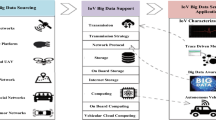Abstract
Connected devices, paradigms of the Internet of Things and Big Data increasingly define our everyday life. In this context, modern automobiles, which are characterized by an increase of electronic components and extensive sensor devices, potentially are becoming a new kind of mobile and anytime accessible sensors. In this context “Extended Floating Car Data” (XFCD) is a rich geocoded dataset for vehicle, traffic, and environment data, augmenting more traditional geospatial databases. This paper deals with the approach to collect and use this data from automobiles for context-aware geospatial analyses by combining the sensor parameters with a spatial and temporal component. These data concern the concept of XFCD as geo-information and needs to be made available and applicable to spatio-temporal visualization. For this approach, research already conducted should be considered and findings should be used for more in-depth research.
Access this chapter
Tax calculation will be finalised at checkout
Purchases are for personal use only
Similar content being viewed by others
References
Doctorow, C.: The Coming War on General Computation. Presented at 28C3 conference in Berlin, Germany (2011). Transcribed by Joshua Wise www.joshua@joshuawise.com. https://github.com/jwise/28c3-doctorow/blob/master/transcript.md. Accessed May 2016
Pfoser, D.: Floating car data. In: Shekhar, S. and Xiong, H., (eds.) Encyclopedia of Geographical Information Sciences, p. 321. Springer, New York (2008a)
Lorkowski, S.: Erste Mobilitätsdienste auf Basis von “Floating Car Data”. In: Beckmann, S. et al., (eds.) Stadt, Region, Land – 4. Aachener Kolloqium “Mobilität und Stadt” (AMUS). Institut für Stadtbauwesen der RWTH, Aachen (2003)
Halbritter, G. et al.: Strategien für Verkehrsinnovationen: Umsetzungsbedingungen, Verkehrstelematik, internationale Erfahrungen. edition sigma, Berlin (2008)
Breitenberger, S. et al.: Extended Floating Car Data – Potenziale für die Verkehrsinformation und notwendige Durchdringungsraten. In: Rohleder, M., (eds.) Straßenverkehrstechnik, 10/2014, pp. 522–531. Kirschbaum Verlag, Bonn (2004)
CiA: History of CAN technology. CAN in Automation e.V., Nuremberg (2016). http://www.can-cia.org/can-knowledge/can/can-history/. Accessed May 2016
McKinsey: Big Data: The Next Frontier for Innovation, Competition, and Productivity. McKinsey Global Institute, McKinsey & Company Inc., New York (2011). http://www.mckinsey.com/business-functions/business-technology/our-insights/big-data-the-next-frontier-for-innovation. Accessed May 2016
Schneider, S., et al.: Extended floating car data in co-operative traffic management. In: Barceló, J., Kuwahara, M. (eds.) Traffic Data Collection and its Standardization, pp. 161–170. Springer, New York (2010)
Stottan, T.: XFCD als Basistechnologie für die Mobilität 3.0 - Entstehung, Entwicklung, Zukunftsanwendungen, Marktentwicklung. In: Proff, H., et al. (eds.) Schritte in die künftige Mobilität, pp. 47–59. Springer Fachmedien, Wiesbaden (2013)
Schäffer, F.: OBD-Fahrzeugdiagnose in der Praxis. Franzis Verlag, Haar (2012)
Voland, P.: Webbasierte Visualisierung von Extended Floating Car Data (XFCD) - Ein Ansatz zur raumzeitlichen Visualisierung und technischen Implementierung mit Open Source Software unter spezieller Betrachtung des Umwelt- und Verkehrsmonitoring. Master Thesis, University of Potsdam, unpublished (2014)
AOBDR: android-obd-reader and obd-server, Github Repository Android OBD-II Reader Project. Paulo Pires pjpires@gmail.com (2016). https://github.com/pires/. Accessed May 2016
CartoDB: CartoDB Github Repository. Vizzuality Inc., New York (2016). https://github.com/CartoDB/cartodb/. Accessed May 2016
Han, J.: Spatial OLAP. In: Shekhar, S., Xiong, H. (eds.) Encyclopedia of Geographical Information Sciences, pp. 809–812. Springer, New York (2008)
BLfU: Berechnung CO2 Emissionen. Bayer. Landesamtes für Umwelt, Augsburg (2016). http://www.izu.bayern.de/praxis/detail_praxis.php?pid=0203010100217. Accessed May 2016
Pfoser, D.: Map-matching. In: Shekhar, S. and Xiong, H., (eds.) Encyclopedia of Geographical Information Sciences, pp. 632–633. Springer, New York (2008b)
Bollmann, J., Koch, W.-G.: Lexikon der Kartographie und Geomatik. Spektrum Akademischer Verlag, Heidelberg (2005)
Heidmann, F.: Interaktive Karten und Geovisualisierungen. In: Weber, W., Burmeister, H., Tille, R. (eds.) Interaktive Infografiken, pp. 66–67. Springer, Berlin (2013)
Asche, H., Engemaier, R.: From concept to implementation: web-based cartographic visualisation with cartoservice. In: Murgante, B., Gervasi, O., Misra, S., Nedjah, N., Rocha, A.M.A., Taniar, D., Apduhan, B.O. (eds.) ICCSA 2012, Part II. LNCS, vol. 7334, pp. 414–424. Springer, Heidelberg (2012)
Acknowledgement
This research work is funded with a PhD scholarship by the German Research Foundation (DFG) within the research training group 1539 “Visibility and Visualisation - Hybrid Forms of Pictorial Knowledge” at the University of Potsdam. This support is gratefully acknowledged. The above PhD project is supervised by Hartmut Asche (University of Potsdam) and Frank Heidmann (Potsdam University of Applied Sciences).
Author information
Authors and Affiliations
Corresponding author
Editor information
Editors and Affiliations
Rights and permissions
Copyright information
© 2016 Springer International Publishing Switzerland
About this paper
Cite this paper
Voland, P. (2016). Processing and Geo-visualization of Spatio-Temporal Sensor Data from Connected Automotive Electronics Systems. In: Gervasi, O., et al. Computational Science and Its Applications -- ICCSA 2016. ICCSA 2016. Lecture Notes in Computer Science(), vol 9788. Springer, Cham. https://doi.org/10.1007/978-3-319-42111-7_23
Download citation
DOI: https://doi.org/10.1007/978-3-319-42111-7_23
Published:
Publisher Name: Springer, Cham
Print ISBN: 978-3-319-42110-0
Online ISBN: 978-3-319-42111-7
eBook Packages: Computer ScienceComputer Science (R0)




